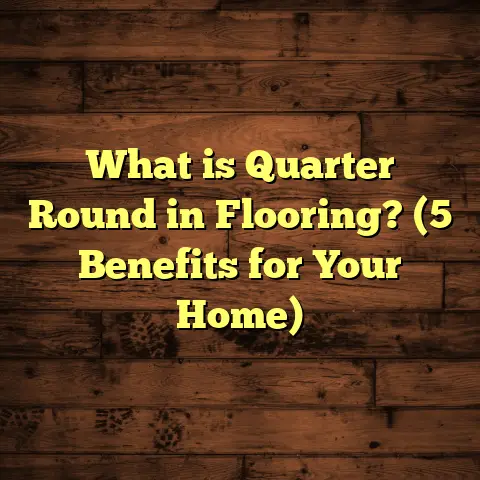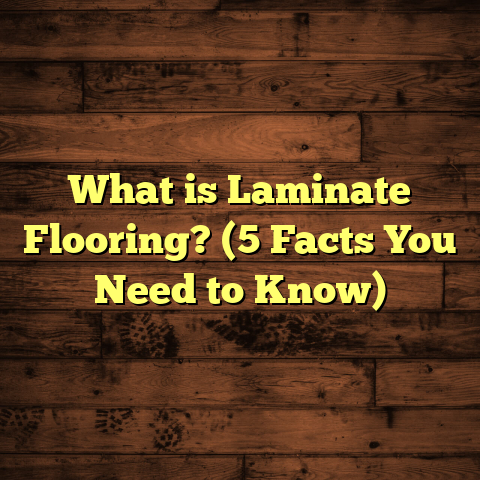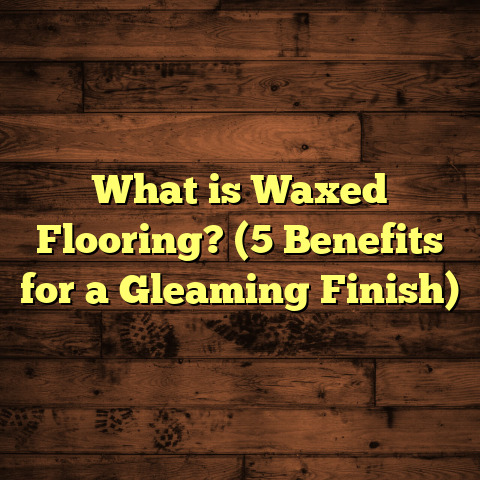What is Laminate Flooring That Looks Like Wood? (5 Key Benefits)
Have you ever been drawn to that warm, inviting look of hardwood floors
and thought, “I wish I could have that in my home”? Maybe you’ve run
your fingers over a real wood plank or admired it in someone else’s house,
wondering if there’s a way to get that look without spending a fortune or
going through a long renovation. I’ve been right there with you more times
than I can count.
As someone who has spent years installing and working with every type
of flooring imaginable, I often get asked about laminate flooring that looks
like wood. What exactly is it? Is it really a good alternative to hardwood?
And what should you know before taking the plunge? I’m going to walk you
through everything I’ve learned—from the basics to insider tips, cost
breakdowns, and real-world experiences.
What is Laminate Flooring That Looks Like Wood?
Let’s start with the basics. You might already know that laminate flooring is
a popular synthetic option, but what does it mean when we say it “looks like
wood”? Essentially, this type of laminate is designed specifically to mimic the
appearance of natural hardwood floors.
Think of laminate flooring as a multi-layered product built to combine durability,
style, and cost-effectiveness:
- Top Wear Layer: This clear layer acts as a shield against scratches, stains,
and fading from sunlight. It’s made from melamine resin or aluminum oxide,
which ensures the surface can take daily wear and tear. - Decorative Layer: This is where the magic happens. A high-resolution photograph
of wood grain is printed onto this layer. The photographic technology is so advanced
that it captures minute details such as knots, grains, color variations, and even tiny imperfections
found in natural wood. - Core Layer: Usually made from high-density fiberboard (HDF) or medium-density fiberboard (MDF),
this gives the flooring its strength and stability. It also provides some resistance to moisture and impact. - Backing Layer: A balancing layer that adds structural integrity and helps protect against moisture from below.
The combination of these layers results in a flooring product that is visually very close to hardwood but comes with benefits that natural wood can’t always offer.
How Realistic Does It Really Look?
I remember one installation where a client was so skeptical about laminate floors
that looked like wood she insisted on comparing samples side by side with her existing hardwood.
After a thorough inspection, she admitted that under normal lighting conditions, the laminate was
virtually indistinguishable from the real thing.
What makes this possible is the textured surface on many laminate brands that replicate the feel of real wood grain—sometimes even incorporating embossed or hand-scraped patterns. This texture adds depth and realism beyond just the printed image.
Why Choose Laminate Over Hardwood?
You might ask yourself, “If hardwood is so beautiful, why opt for laminate?” There are several reasons that come up time and again in my work.
Cost Savings Without Compromising Style
Hardwood floors can cost anywhere from $8 to $15 per square foot for materials alone —
and then add installation charges, which can push the total price even higher. Laminate flooring generally falls between $1 and $5 per square foot depending on quality.
In one project I worked on recently, a family wanted the look of walnut floors but had a tight budget due to other renovation expenses. We went with a mid-range laminate option that gave them the rich color and grain they wanted for less than half the cost of installing real walnut planks.
Faster, Easier Installation
Hardwood installation often requires specialized tools, nails or glue, and sometimes sanding and finishing on-site—steps that can extend the project timeline by several days or weeks. Laminate uses a floating floor design with tongue-and-groove or click-lock planks that snap together over an underlayment—no nails or glue required.
From my experience supervising DIY installers and professionals alike, laminate can be laid much quicker—sometimes completing an entire room in just one weekend.
Durability for Busy Homes
Let’s face it: hardwood floors are beautiful but can be vulnerable to scratches, dents, and moisture damage. Laminate’s tough wear layer makes it resistant to scratches from pets, kids’ toys, and everyday foot traffic.
According to a study by the National Wood Flooring Association (NWFA), high-quality laminate floors can last 15-25 years in residential use—comparable to engineered hardwood and sometimes longer in high-traffic areas.
Low Maintenance That Fits Your Lifestyle
One thing I always tell clients is how much easier laminate floors are to maintain compared to real wood. You don’t need special polishes or waxes; just sweep or vacuum regularly and mop with a damp cloth when necessary.
Spills wipe up easily without staining or warping if cleaned quickly—a big help in kitchens or entryways where messes happen often.
Variety of Styles to Match Any Taste
Laminate flooring manufacturers offer an incredible range of colors, patterns, and textures—from pale whitewashed oak to deep mahogany, rustic hand-scraped looks to sleek modern finishes.
In my projects, I enjoy helping homeowners find laminate planks that perfectly match their furniture and décor style.
My Personal Stories With Laminate Floors
Over the years, I’ve seen firsthand how laminate flooring can transform homes and lives.
I recall a young couple who moved into their first home on a tight budget but wanted something stylish. We installed maple-look laminate throughout their living room and kitchen. They were thrilled when they saw how much warmth and character it added without blowing their savings.
Another memorable job involved a daycare center where durability was key. The owners chose commercial-grade laminate due to its scratch resistance and ease of cleaning. After three years of constant use by energetic kids, the floors still looked great—unlike their previous hardwood floors that needed refinishing every year.
I also witnessed an interesting case where a customer initially bought hardwood but decided to sell their house shortly after installation due to job relocation. They lost value on the hardwood floor investment because buyers factored in potential maintenance costs. Meanwhile, my other client with laminate floors sold quickly because buyers appreciated the fresh look and low upkeep.
Data-Backed Insights and Industry Trends
To give you some concrete numbers: according to a 2023 report by Grand View Research, the global laminate flooring market was valued at approximately $14 billion—with steady annual growth driven by demand for affordable wood alternatives.
Consumer surveys show:
- 68% of homeowners choose laminate because of cost-effectiveness.
- 55% appreciate its ease of installation for DIY projects.
- 49% cite durability as a deciding factor over natural hardwood.
In terms of maintenance costs over 10 years, laminate floors typically cost 40% less than hardwood when factoring in refinishing and repairs.
How I Use Tools Like FloorTally for Cost Estimation
Estimating costs accurately is crucial when planning any flooring project. Early on in my career, I used to spend hours contacting suppliers for quotes and calculating materials manually—which was time-consuming and often inaccurate due to waste factors or labor variations.
FloorTally changed how I approach budgeting. It lets me input room dimensions, select specific laminate brands or textures, and automatically calculates material quantities including waste percentages (usually 5–10%). It also pulls local labor rates for installation which helps me get realistic estimates fast.
This means fewer surprises for me and my clients during the project. It’s not just about price—it helps me plan better so I can recommend options that fit both style preferences and budgets.
What Should You Know Before Choosing Laminate Flooring?
Thickness Matters
Laminate planks come in different thicknesses—typically ranging from 6mm to 12mm or more. Thicker planks feel more solid underfoot and provide better sound insulation. For homes with heavy foot traffic or pets, I recommend going for at least 8mm thickness.
AC Rating Indicates Durability
Look for the Abrasion Criteria (AC) rating on packaging—it tells you how much wear the floor can handle:
| AC Rating | Usage Type | Suitable For |
|---|---|---|
| AC1 | Light Residential | Bedrooms or closets |
| AC2 | Residential | Living rooms or dining rooms |
| AC3 | General Residential & Commercial | Hallways & kitchens |
| AC4 | Heavy Residential & Light Commercial | Office spaces & retail areas |
| AC5 | Heavy Commercial | Public buildings & industrial spaces |
For most homes, AC3 or AC4 is ideal.
Subfloor Preparation is Key
A clean, level subfloor prevents problems like creaking or plank separation down the line. I always check for moisture levels before installing over concrete slabs—too much moisture can cause core swelling even with moisture-resistant laminates.
Don’t Skip Underlayment
Underlayment cushions your feet, reduces noise, and acts as an additional moisture barrier. Some laminates come with pre-attached underlayment; if not, be sure to buy compatible padding.
Handling Moisture Properly
Laminate floors are water-resistant but not waterproof. Avoid standing water or excessive wet mopping; wipe spills quickly. If you live in a damp climate or want to install in bathrooms or basements, look into specialized waterproof laminate options or vinyl plank alternatives.
Comparing Laminate With Other Wood-Look Options
Sometimes clients ask me how laminate stacks up against other popular wood-look floors like:
- Engineered Hardwood: Real wood veneer over plywood core—looks authentic but pricier than laminate and needs more care.
- Luxury Vinyl Plank (LVP): Vinyl-based with realistic wood designs; highly water-resistant but feels softer underfoot than laminate.
- Bamboo Flooring: Natural grass product with wood-like appearance; eco-friendly but varies in durability depending on processing.
Each has pros and cons depending on budget, usage area, and desired look.
Wrapping Up My Take On Laminate Flooring That Looks Like Wood
From my experience working directly with homeowners, contractors, and suppliers alike—laminate flooring that looks like wood offers an unbeatable combination of beauty, durability, affordability, and ease of installation.
It’s ideal if you want:
- A wood floor look without spending hardwood prices
- A quick installation project (DIY-friendly)
- Floors that stand up well to pets, kids, and daily wear
- Minimal cleaning effort
- Lots of style choices
If you’re considering new floors but hesitant about hardwood’s cost or maintenance headaches—laminate might be exactly what you need.
Feel free to ask me any questions about selecting brands or installation tips—I’m happy to share more from my hands-on experience! And if you have tried laminate before, what did you think? Let’s chat!





